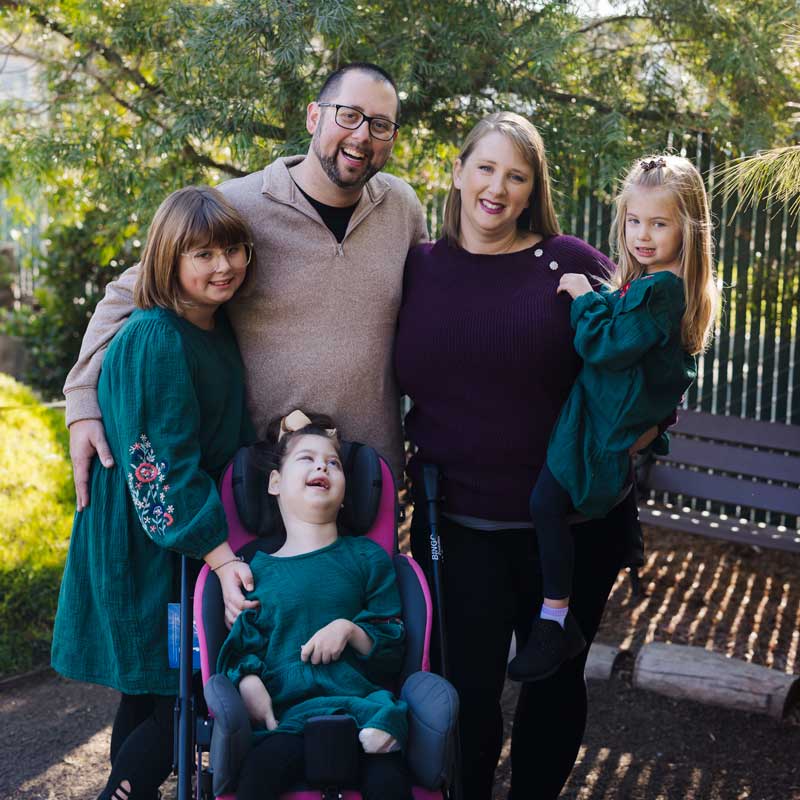Hannah's birth went off without a hitch, and she seemed like a typical newborn. But at two months old, Hannah's mother Mary Detlefsen noticed her daughter's eyes didn't want to fully open and one seemed cloudy - so took her to the family doctor. Thus began an arduous journey of specialist visits, imaging appointments and genetic tests.
Many months later, the family received a diagnosis: Gould Syndrome, a rare disorder caused by mutations in the COL4A1 or COL4A2 genes. Named after the UC San Francisco geneticist who discovered the mutation in mice in 2003, Douglas Gould, PhD, the syndrome's most common symptoms are stroke and eye defects, followed by kidney and muscle abnormalities.
Now Gould is joining with UCSF clinical colleagues in pediatric neurology and pediatric ophthalmology to create the first center in the world focused on patients with COL4A1/2 mutations. The goal is to spare families like Hannah's a painful path to diagnosis and specialist care.
"Because this is a rare disease, many doctors have never heard of it," said Gould, who takes two to four calls a month from parents like Detlefsen whose children are newly diagnosed with Gould Syndrome. "Parents often end up doing research and figure it out, just to get a diagnosis and find their doctors."
Detlefsen eventually learned that Hannah had a stroke prior to birth that caused major brain damage and epilepsy. Now 7 years old with severe physical and cognitive delays, Hannah has become more expressive and adventurous in recent years.
"She has a stable treatment team looking after her, and we've seen her become more open to new people and experiences," Detlefsen said.

"My hope is this new center will help families get to the place we are now, but much faster."
Mary Detlefsen, Hannah's mother
Parents have questions but no answers
At first the center will focus on children as they usually have the most severe form of the syndrome, commonly from a perinatal stroke like Hannah's. About one in 10,000 fetuses have an in-utero stroke, and five in 10,000 newborns have a stroke. Of those perinatal strokes, one-fifth can be traced to a mutation in the COL4A1 or COL4A2 genes. The gene is inherited about 30% of the time.
Eye problems are the second most common issue that leads to a diagnosis of Gould Syndrome. Sometimes a newborn will have abnormal eye movements or a cataract or glaucoma because the front part of their eyeball didn't form properly. These often trigger further testing that eventually reveals the mutation.
Rachel Vassar, MD, pediatric vascular neurologist and Alejandra de Alba Campomanes, MD, UCSF pediatric ophthalmologist at UCSF Benioff Children's Hospitals will co-collaborate on clinical care for the new center. Currently, they have about 15-20 patients with Gould Syndrome, whom they refer to UCSF specialists as needed in nephrology, cardiology, genetics and more.
"As word about the center spreads, we plan to set up a time and day of the week devoted to these patients and involve more clinicians regularly," said de Alba Campomanes.
The center also will conduct research, including a natural history study to learn the range of symptoms that can emerge from the COL4A1/2 mutation, as well as how those symptoms emerge over an individual's lifetime.
"When I encounter patients with this mutation, their families have a lot of questions we don't have answers to," Vassar said. "How do I take care of my child across the lifespan? What are the future implications? Are there differences in risk for them in undergoing surgery? Should they avoid blood thinners because they may be at risk for bleeding? And we are only in the early stages of understanding the answers to these important questions."
Add adults to the mix and the clinical picture gets even more complex, noted Gould, director and vice chair of research in UCSF's Department of Ophthalmology.
"You could have 20 people in the room with a COL4A1/2 mutation and you'd never guess," said Gould. "The disease has been known for such a relatively short period of time and it's highly clinically variable, so it is hard to say how any one patient will progress."
Adults often only learn they have the mutation after being tested at the same time as their affected child, or after having genetic testing ordered for another reason. Some are found to have small issues that don't affect their current health, such as slightly higher protein levels in the urine or a tiny brain bleed.






